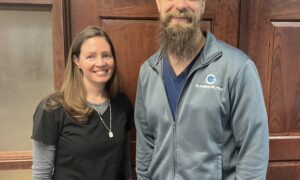Kim Raharja, OD
Four Walmart locations Atlanta, GA
Kim Raharja, OD, is a Walmart-affiliated optometrist with four locations in metropolitan Atlanta. Prior to graduating optometry school, she was involved in information technology and internet marketing. Here she discusses her process in establishing a practice in a corporate setting and how she applied simple marketing techniques to grow that first practice and then to establish and manage others.
Contact: kimraharja@atlantaeyecenter.com.
Bridge from Student to Practitioner
The corporate structure provides a great way to pay off your student loans quickly, and it doesn’t get you bogged down with another loan for buying into a practice. Walmart provides and services the lane equipment and pretesting equipment. There is very little capital investment, and in most cases, you pay a flat rent to Walmart. I am set up as an independent contractor, so the income potential is unlimited.
When you are looking for a corporate partner, it’s important to ask the tough questions. I reached out to one of the district managers that oversaw one of the empty locations. “How many patients do you require me to see an hour? Can I treat glaucoma? Can I dilate all of my patients? How much is the rent? For what expenses am I responsible?” I was very pleased they do not dictate anything about my patient care, and my overhead costs are minimal. The ability to take care of the patients’ visual and medical needs means they will not look elsewhere for eye care.
Reach Out to Mentors
I learned from several mentors. They helped me understand the Walmart culture and the nuances of being in a corporate-affiliated practice. They helped me understand where the best locations would be. They were there to help me, to guide me through some tough patient situations. Before I started my practice, I would visit for a couple of hours to get a feel for how each doctor managed their practice.
Have a Business Plan
When I was looking for my first practice location (and still a fourth-year optometry student), I competed with six other optometrists for the contract for a brand new location. The others had more experience. I had to submit a business plan. I received several samples from other doctors, and I found a lot of online tools. I wrote a 13-page business plan, showing marketing, hours and costs. What really came across was how aggressive I would be in acquiring patients for my practice.
Starting Up, Getting Seen
One particular location was near a college. It was perfect. This would assure the practice a lot of contact lens wearers, whom I am interested in serving. I was aggressive the first year about getting out in the local community. I went to vision screenings and health fairs, treating everyone from kids to seniors–getting the word out and taking their insurance, and making appointment on the spot. Getting the word out and taking their insurance plans was key to converting customers to patients. I built a web site (www.atlantaeyecenter.com), where patients could book online appointments with my 4patientcare system 24/7. Atlanta is a market where there are so many people moving in and out, the easiest way to find a doctor is online. Four years later, one out of five patients find me online.
Since everything was new to me, I had to figure out how to get into insurance plans. I hired a medical billing company that held my hand through the whole process. We are on five major plans, and we have about 15 other smaller plans. We called all of the local major companies and major employers, as well as the university, and asked what plans they were on. We prioritized and applied to the five most popular plans.
Good Exposure: Health Fairs
I went to about 25 health fairs my first year of practice. Once you get into one and you show a willingness to participate, you get into more. There are about four or five health fair coordinators who organize anywhere from one to five health fairs for the year. Some find me online. Once you’re hooked up with them, they take care of the rest.
Some health fairs are sponsored by the insurance plan, and an invitation is extended to you if you are part of their panel. Some are organized by community leaders such as the YMCA or our Senator’s community outreach program.
Getting Ready for Growth
I was doing well at the first location the end of my first year. I wanted more of a challenge. Some doctors are content with one location, but I realized having more than one location would offer me more financial freedom. When one optometrist didn’t renew a contract, I talked to the district manager. I revised my business plan, this time incorporating the three potential practice locations. I assessed each location’s demographics and local needs.
I now have leases on four locations. One location was brand new. Two other locations were struggling.
There are different challenges between a new location and an established one. Some patients are loyal and will move along with the departing optometrists if they move nearby. If the practice has been empty for a long period of time, many patients will just assume there will not be a doctor, and they establish a relationship with another doctor. What did the last OD do or not do? Some were on vision plans, but not doing medical billing on medical insurance plans. People coming in with dry eye or allergies had been referred out.
Taking Your Time
Once you can prove you can succeed in one location, it’s easier to get more. I wouldn’t encourage people to take on a lot. Test the waters and build. If you put the time in and BUILD repeat patients, your practice can accelerate very quickly, which helps pay off those student loans. It’s a great way to build a practice. IIt’s okay to work at another location while you build your practice. Use it as a learning opportunity. Being employed by another practice can help you get through the slow times. Year three tends to be the time when your repeat patients and new patients help accelerate your growth.
There are benefits to a group practice and partnering with Walmart—-expenses are shared for marketing and for staff. The affiliation with Walmart has also meant very little capital investment.
Within the corporate setting, there’s so much variety. We advertise that we practice full-scope optometry, and we market to diabetic patients. Our niche is also very young patients. We’ve been able to get into the schools and day care and market annual eye exams to kids so they come every year.
In one location, we installed advanced instrumentation. We call that our glaucoma center, and all of our patients who are potential glaucoma suspects have an opton to go there for further evaluation.
Getting the Right Help
The doctors and technicians in my practice are tech savvy. Previous experience with electronic medical records is a plus. Anyone with computerphobia was filtered out. I also wanted to see how the staff candidates would handle customer service, by seeing if they were friendly and asking a lot of scenario-based questions. In terms of hiring other ODs, I wanted to hire people with the same approach to treatment that I practice with my patients. Everyone is given a 90-day trial period.
You have to be engaged, test and assess the staff continuously. You have to learn from past mistakes. When it comes to the doctors and technicians, I want them to accept constructive criticism, so they can be better. You usually find if they are a good fit in the first 30 days. Sometimes, I might pay doctors for a day and spend a day with them to observe how they work and interact with patients. Some of my fill-in doctors stay on permanently because of the staff. It’s important that the doctor impresses my staff as well.





















